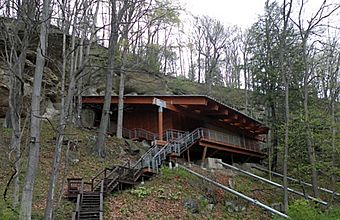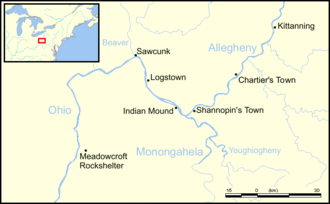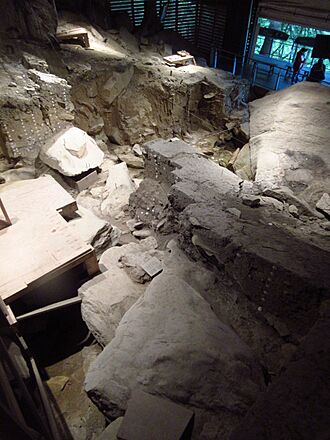Meadowcroft Rockshelter facts for kids
|
Meadowcroft Rockshelter
|
|

Meadowcroft Rockshelter in Jefferson Township, Pennsylvania, U.S.
|
|
| Location | Jefferson Township, Washington County, Pennsylvania, U.S. |
|---|---|
| Nearest city | Avella, Pennsylvania |
| Area | 0.2 acres (0.081 ha) |
| NRHP reference No. | 78002480 |
Quick facts for kids Significant dates |
|
| Added to NRHP | November 21, 1978 |
| Designated NHL | April 5, 2005 |
The Meadowcroft Rockshelter is a very important archaeological site in Pennsylvania, near the town of Avella. It's a natural rock shelter under a cliff, looking over a stream called Cross Creek. This special place holds clues that people might have lived there for over 19,000 years! If this is true, it would be one of the oldest known places where humans lived continuously in North and South America.
Meadowcroft Rockshelter is about 27 miles southwest of Pittsburgh. Today, it is part of the Heinz History Center in Pittsburgh. You can visit a museum there and see a recreated village from the 1570s, showing how the Monongahela culture Native Americans lived. Meadowcroft Rockshelter is recognized as a National Historic Landmark and a Pennsylvania Commonwealth Treasure. It is also an official project of Save America's Treasures.
Contents
What is the Meadowcroft Rockshelter?
The rockshelter is a natural cave-like space formed under a large, overhanging cliff. This cliff is made of a type of brown sandstone called Morgantown-Connellsville sandstone. Meadowcroft is located in the Allegheny Plateau, which is part of the larger Appalachian Basin region.
Discovering Ancient Life at Meadowcroft
People lived at Meadowcroft Rockshelter for thousands of years. Native Americans left the site around the time of the American Revolutionary War. It was rediscovered much later.
How Were the Finds Made?
In 1955, a man named Albert Miller found the first ancient objects in a groundhog burrow. He waited to report his discovery to protect the site from people who might damage it. Later, he contacted James M. Adovasio, an archaeologist.
Dr. Adovasio led the first major excavations at the site from 1973 to 1979. These digs were done by the University of Pittsburgh. More work continued through 1989. Since the 1990s, Dr. Adovasio has continued his research through the Mercyhurst Archaeological Institute. The way they dug at Meadowcroft is still considered very advanced and careful. It is known as one of the most carefully excavated sites in North America.
What Was Found at Meadowcroft?
Archaeologists found many ancient objects deep underground at Meadowcroft, some as far down as 11.5 feet. These finds include tools like pottery, bifaces (tools sharpened on both sides), and lamellar blades (long, thin stone flakes). They also found a special type of spear point called a lanceolate projectile point.
Some of the tools found were "fluted points," which are a sign of the Paleo-Indians who lived thousands of years ago. The discovery of flint from Ohio, jasper from eastern Pennsylvania, and seashells from the Atlantic coast suggests that the people living here traveled widely or traded with distant groups. They also found evidence of hearths, which are ancient fireplaces, that were used many times.
Meadowcroft also has the largest collection of plant and animal remains ever found in eastern North America. The dry conditions inside the rockshelter helped preserve these items very well. They found remains from 149 different animal species. Evidence shows that people gathered small animals and plants like corn, squash, fruits, nuts, and seeds.
How Old Are the Finds?
Scientists used Radiocarbon dating to figure out how old the objects are. This method suggests that people started living at Meadowcroft about 16,000 years ago (around 14,000 BCE). Some evidence even points to activity as early as 19,000 years ago (around 17,000 BCE).
These very early dates are still debated by some archaeologists. However, tests on the samples showed no signs of contamination from ancient carbon in the ground. If these dates are correct, Meadowcroft was used even before the well-known Clovis culture period. This would mean that humans lived in the Americas much earlier than many once thought. Meadowcroft Rockshelter offers a special look into the lives of ancient hunters and gatherers. Evidence from the Paleoindian, Archaic, and Woodland times has all been found at the site.
The Miller Complex Tools
A unique type of arrowhead was found at Meadowcroft, which archaeologists named the Miller Lanceolate projectile point. Similar points have been found at nearby sites too. This group of tools, called the Miller complex, includes thin tools sharpened on both sides, small blades, and tools made from flakes. These tools show how people made and fixed their tools.
The Miller complex is also defined by other finds in the Cross Creek area, where more lanceolate points and small blades were discovered. According to archaeologists like Adovasio, these tools look similar to those found in Eurasia and Siberia. They also noted that these small blades are not found in later Paleoindian tool collections in this region, making the Miller complex unique.
Another important site for understanding the Miller complex is the Krajacic Site, about ten miles southeast of Meadowcroft. This site also had many distinctive Meadowcroft-style blade tools. Similar points, called Early Triangular type, have been found at Cactus Hill in Virginia. Some similar discoveries were also made at the Page-Ladson site in Florida.
Because Meadowcroft shows such a long history of human occupation, it is a very important site for comparing with other ancient discoveries. Tools from Meadowcroft are often used to evaluate claims of very early human presence at other sites in North and South America. Some experts believe that later spear point styles, like Clovis and Folsom points, might have developed from these earlier unfluted lanceolate points.
Visiting Meadowcroft Rockshelter
In 2008, the rockshelter was updated so visitors can easily see some of the tools and ancient campfires made by the first Americans thousands of years ago. The site is recognized as a Pennsylvania Commonwealth Treasure and is an official project of Save America's Treasures.
When you visit, you can also see a recreation of a 16th-century Monongahela culture village. There are also buildings from the 18th and 19th centuries, showing how European settlers lived.
The Meadowcroft Rockshelter was added to the National Register of Historic Places in 1978. In 1999, the Pennsylvania Historical and Museum Commission placed a historical marker at the site to highlight its importance. It was named a National Historic Landmark in 2005. The Washington County History & Landmarks Foundation also recognizes it as a historic public landmark.
See also
 In Spanish: Meadowcroft Rockshelter para niños
In Spanish: Meadowcroft Rockshelter para niños





